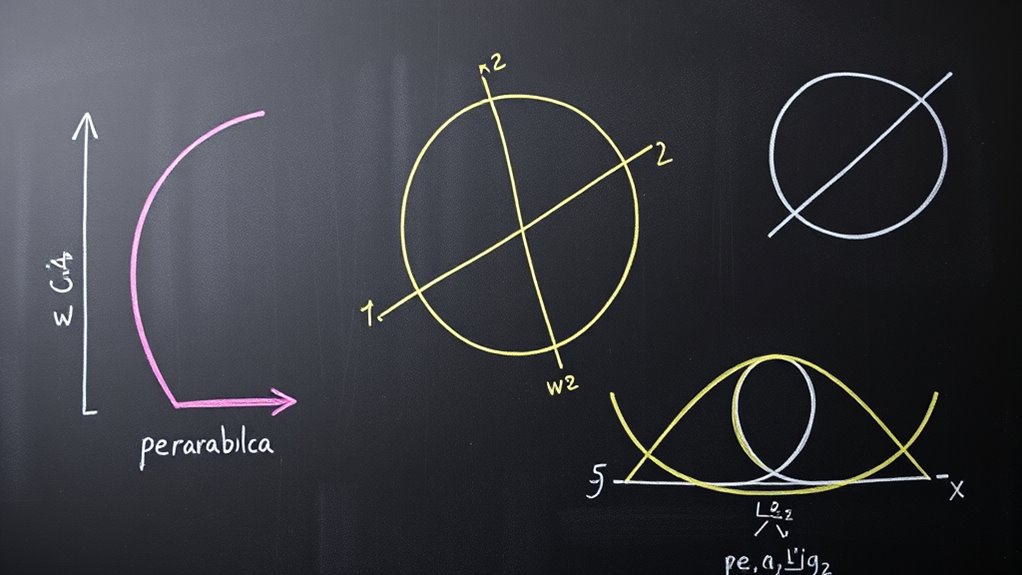Conic sections—parabolas, ellipses, and hyperbolas—are shapes formed by slicing a double cone at different angles. Each has unique equations and properties: parabolas focus signals, ellipses relate to planetary orbits, and hyperbolas appear in navigation systems. Understanding their equations helps you see how these shapes work in real life, from architectural designs to communication devices. Keep exploring, and you’ll uncover even more about these fascinating geometric forms.
Key Takeaways
- Conic sections include circles, ellipses, parabolas, and hyperbolas, formed by slicing a double cone at different angles.
- Each conic has unique equations and properties, such as foci, axes, and directrices, that define their shape.
- Parabolas reflect signals to a focus and are widely used in satellite dishes and projectile motion analysis.
- Ellipses have constant sum distances to two foci, important in planetary orbits and elliptical architecture.
- Hyperbolas feature two branches with foci outside the curves, utilized in navigation and radio signal processing.

Have you ever wondered how shapes like circles, ellipses, parabolas, and hyperbolas are related? These curves are all conic sections, formed by slicing a double cone with a plane at different angles. Understanding their focus on conic section equations helps you grasp their unique properties and how they appear in everyday life. Conic sections are described mathematically by specific equations that vary depending on the shape. For instance, the equation for a circle is centered at a point with a fixed radius, like ((x – h)^2 + (y – k)^2 = r^2). Ellipses follow the form (frac{(x – h)^2}{a^2} + frac{(y – k)^2}{b^2} = 1), where the sum of distances from any point on the ellipse to two fixed points (foci) remains constant. Parabolas are represented by equations like (y = ax^2 + bx + c) or in vertex form, which makes their focus and directrix easier to identify. Hyperbolas take the form (frac{(x – h)^2}{a^2} – frac{(y – k)^2}{b^2} = 1), with their foci lying outside the curve, defining their shape. A key aspect of conic sections is the integration of AI technology, which enhances their applications in fields like engineering and navigation.
These equations are not just abstract math; they have concrete real-world applications. For instance, the focus on conic section equations helps engineers design satellite dishes and telescopes, as parabolas reflect signals to a single focus point, maximizing efficiency. Architects use ellipses and hyperbolas to create aesthetically pleasing and structurally sound buildings. Elliptical arches distribute weight evenly, which is why many historic bridges and domes incorporate them. Parabolas are essential in projectile motion analysis, helping physicists and engineers predict the path of objects like projectiles or sports balls. Hyperbolas appear in navigation systems and radio signal processing, where the difference in distances from two fixed points (foci) helps locate positions accurately.
Frequently Asked Questions
How Are Conic Sections Used in Real-World Engineering Applications?
You can see conic sections in real-world engineering through satellite technology and architectural design. Satellite dishes use parabolas to focus signals efficiently, ensuring clear communication. In architecture, ellipses and hyperbolas shape stunning structures, providing both aesthetic appeal and structural integrity. These shapes help engineers optimize performance and design innovative, resilient buildings and technology that serve everyday needs seamlessly.
What Are the Historical Origins of Studying Conic Sections?
Like the timeless story of Daedalus and Icarus, the study of conic sections has ancient Greek roots. You discover that mathematicians from that era laid the groundwork for understanding shapes like parabolas and ellipses. Their curiosity sparked a mathematical development that influences modern science and engineering. This pursuit of knowledge reflects humanity’s enduring desire to explore and comprehend the universe’s geometric beauty, echoing through history to today.
How Do Conic Sections Relate to Planetary Motion?
You see, conic sections directly relate to planetary motion because they describe the orbital paths planets take around the sun. These trajectories are elliptical, matching the shape of ellipses, which explains why planets follow elongated orbits. Parabolas and hyperbolas also come into play for specific celestial events like comets or spacecraft trajectories. So, understanding conic sections helps you grasp the fundamental shapes that govern planetary and other celestial motions.
Can Conic Sections Be Visualized Dynamically With Modern Technology?
Imagine watching a dance unfold in real-time—modern technology makes this possible with conic sections. You can explore their shapes through interactive visualization and dynamic modeling, turning static diagrams into lively, engaging experiences. With software like GeoGebra or Desmos, you see how parabolas, ellipses, and hyperbolas evolve, helping you grasp their properties intuitively. This visual approach transforms complex math into an accessible, vivid journey.
What Are Common Misconceptions About the Properties of Conic Sections?
You might believe some misconception myths about conic sections, like thinking all ellipses look like circles or hyperbolas always open widely. Property clarifications reveal that these shapes have specific characteristics, such as foci, directrices, and eccentricity, which are often misunderstood. Recognizing these myths helps you understand the true properties of conic sections, ensuring you grasp their unique geometric behaviors without confusion.
Conclusion
Now that you’ve uncovered the secrets of conic sections, you hold the key to a universe of shapes and patterns. These curves are like the heartbeat of geometry, each telling its own story of elegance and mystery. As you explore parabolas, ellipses, and hyperbolas, remember—you’re not just learning math; you’re revealing a symphony of curves that dance through the fabric of our world. Embrace this knowledge, and let your curiosity soar like a soaring parabola.









